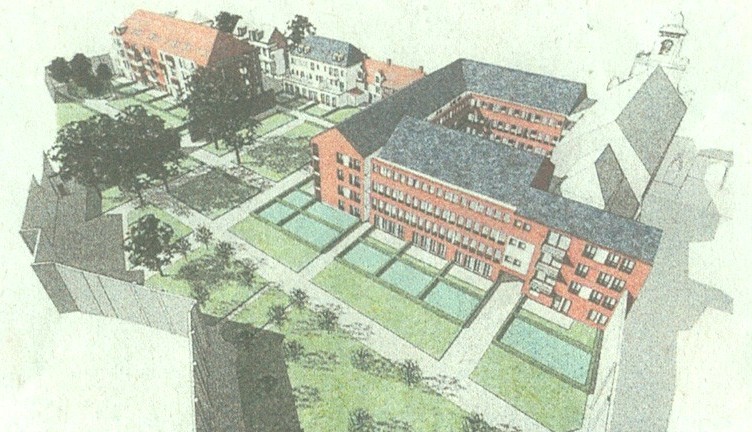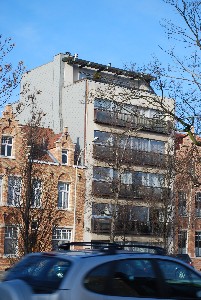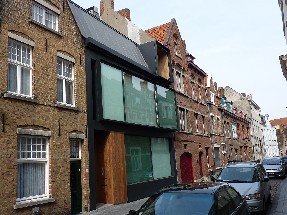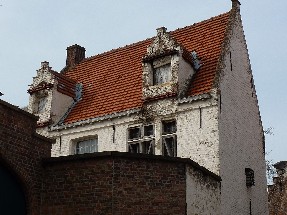Presentatie van ons standpunt aan de delegatie van de Unesco/Icomos:
Bruges, an UNESCO world heritage city

One of the reasons why Bruges has become a World Heritage city is the exceptional conservation of its medieval tissue and structure as a whole (cfr map of Marcus Gerards 1562).
This tissue and structure is characterized by a maze of small winding streets and canals with small sized houses of typical style and a lot of little squares and green open areas. Within this tissue the community has built its palaces, guild houses, belfry, merchant houses, market places, schools, churches, convents, beguinages…The medieval city is surrounded by a very typical egg like double canal system from 1297. The outer canal system still shows the relicts of the bastions. Through the different economical, political, cultural and architectural developments over the centuries Bruges has remarkably kept its characteristic tissue and structure: each century has left behind the testimony of its activity without essentially disturbing this tissue and structure. The gothic and neogothic style, more than any other style, remained all the time the most characteristic aspect of the city.
The city thanks this conservation for a great deal to the decline of its economical strength since the 17th century. It is only since the late 19th century and the 20th century that the city has become aware of its heritage value. It started with varying success to protect this heritage.
In the sixties of the previous century however because of the increasing wealth a lot of typical houses were demolished and replaced by larger houses and apartment buildings mostly of plain architecture. In reaction to this, action groups, such as the Marcus Gerards foundation, have successfully realized a change in the mentality of the community to preserve its heritage.
In the mean time many buildings are classified and the belfry, the beguinage and the city are listed as World Heritage.
However, the destructive mentality of the sixties has come back.

1. The city has become the playground of the developers.
Because of its attraction and the scarcity of land and housing , the selling prices of land and housing in the inner city have increased steeply over the last years. The developers buy the small houses to build new houses with more levels to make the development more profitable. Others buy the scarce open areas or abandoned offices, schools or convents to build housing complexes and large apartments buildings (see hereby plans for appartmentbuildings in the conventgarden of the red nuns in teh Katelijnestraat). Most of those buildings are of ordinary architecture, disturbing the existing tissue and general image of the street .

The objective of the city administration is to attract more people into the inner city , which in itself is good. However in combination with the above
mentioned attitude of the developers this results often in trying to build large buildings with as many inhabitants as possible .
Another result is that the last open areas and gardens of convents and of properties are filled up, resulting in the loss of the attractive inherited structure.

2. The new statement of the city administration is: demolishing of old buildings is acceptable when they are replaced by new valuable architecture.
This slogan seems all right but in only few occasions it leads to good results. In most cases the new buildings, even of undeniable good architecture, do not fit into the street image. Moreover in several cases an old house, even ordinary, is an integral part of the image of the street. The danger is that this slogan is an excuse to demolish. Once demolished it is lost forever. Therefore new architecture should be evaluated very carefully and objectively by all involved services, including the UNESCO/ICOMOS for important projects.
In order to avoid abuses, there should be no permission given to demolish or to modify a building before the permission of the new building or modified building is totally permitted by all the involved services.
In some cases the administration is not even aware of the value of old structures and is giving permission to demolish without involving the heritage services.
A fund should be created to avoid unfinished renovation or building in case of bankruptcy.

3. Another statement of the administration is: this site is neglected and not maintained and the buildings are instable and the only way to solve this is to demolish and to build something new.
There is no excuse to let a site (purposely?) be neglected, especially when this place is of value to the tissue of the city. The administration has the means and the duty to avoid this, at least to enforce
a conservatory renovation. A flabby attitude give way to abuse: negligence becomes a means to get rid of old houses or open areas.
4. In most cases an alternative use of an old building ( if needed with minor modifications) can avoid the demolition.
Such an alternative use should be the first consideration and priority but is often not thoroughly and timely examined or is rejected because of more profitable projects . This search for new use will become very imperative in the near future. Old buildings, currently used by the administration of Flanders will be abandoned to move to the new office building near the railway station. Others currently used by the city administration will be abandoned within the next 5 to 10 years to move to an office building in the Hauwerstraat.
5. To be a World Heritage city is great, but it remains necessary to comfortably live in it.
This means that traffic , which in most cases is contrary to a city with a medieval street tissue, should be minimized. This entails that large complexes that attract a lot of traffic should be avoided, such as large rotation parkings , shopping centers, event buildings,….
Comfort also makes adaptations to the modern way of life necessary. However these should be done after thorough evaluation and with respect for the heritage.
The above situation makes it necessary to classify as many buildings and street views as possible. Only in this way we have the certainty that the necessary services are consulted and that the necessary investigations are performed. Our society vzw Erfgoedforum Brugge has applied for several classifications of valuable buildings. However in some occasions the city opposed itself to the classification and the heritage service postponed some applications because of lack of personnel .The situation becomes even more problematic: since recently the city of Bruges can decide autonomously to give permissions to demolish and build, without consulting the heritage services, except for the classified buildings. A permission to demolish will be given within 75 days . An appeal to the High Court against a decision of the city will no longer be possible.
Recommendation:
Since the title of World Heritage city involves the duty to use all legal possibilities to protect and preserve the city and because of the reasons mentioned above, we would ask the UNESCO to require from the city and the region of Flanders the official classification of the “ inner city as a whole”. Legislation for such a classification already exists since several years. Only such a classification can avoid the loss of control on the conservation of the city, because of the reasons mentioned above.

